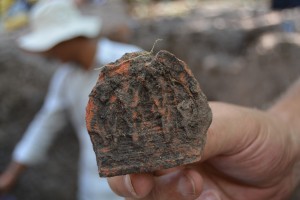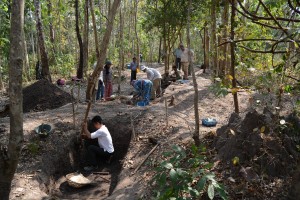The TBT team has conducted two seasons of excavation and survey within Preah Khan of Kompong Svay.
The first campaign (January-February 2015) concentrated on the 4-sided standing Buddha tower known as Preah Chatumukh and settlement and ritual sites within the northeast quadrant of Banteay Knong (3rd enclosure).
Preah Chatumukh
Research at Preah Chatumukh sought to identify when the standing Buddha tower was constructed. Survey revealed that the tower is situated on a raised platform surrounded by a moat and connected to the baray embankment by a causeway. Directly in line with the causeway is a laterite terrace situated on the inside edge of the reservoir. These two structures were likely built as part of the same building project.
Banteay Knong (3rd enclosure)
Excavation inside Banteay Knong attempted to recover aspects of daily life within the temple complex. Unfortunately massive looting activities that took place across the enclosure during the last decades of the 20th century have overturned much of the area inside the 3rd enclosure. This first campaign was therefore focused on locating undisturbed areas. Two trenches placed on a large embankment revealed the diversity of material culture (ceramics, metals, stonework) but the contexts were redeposited. The third trench was positioned near a square laterite terrace. Excavation in and around the structure uncovered a small brown glaze foundation pot as well as a clay stamp depicting the Buddhist triad of the Buddha flanked by Avalokitesvara and Prajnaparamita.
The second campaign (January 2016) focused within one of the urban grid blocks located in the northwest quadrant of Banteay Knong. This western half of the grid block was largely untouched by previous looting activities and excavation revealed numerous in situ features including occupation layers, post holes, laterite causeways, drainage canals and pits. We were able to document the relationship between water infrastructure and occupation on the edge of the grid block as well as identify differences in activity areas in the center of the mound.




